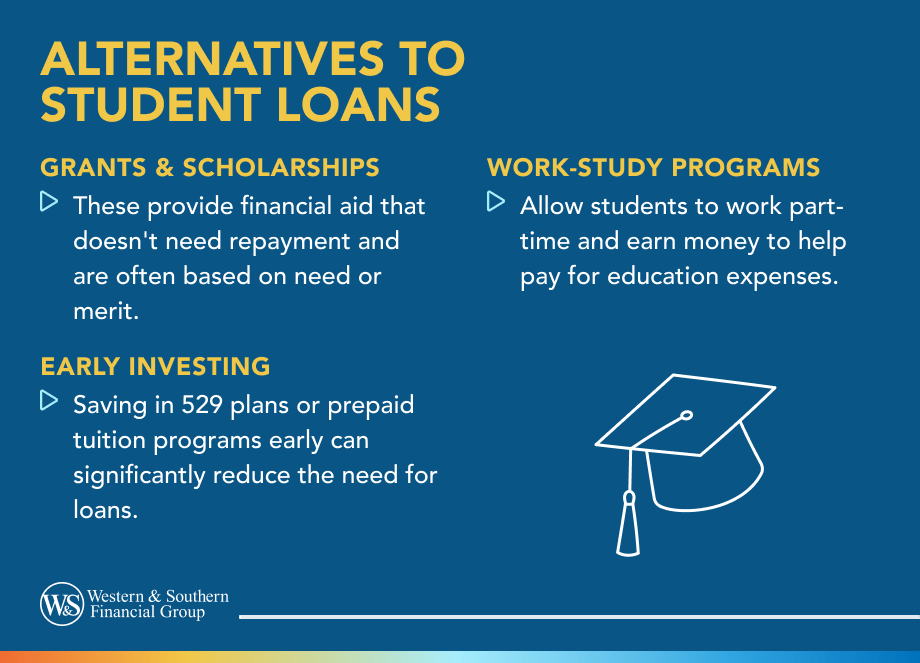

Key Takeaways
- Grants and scholarships are popular for college funding because they don’t require repayment and are often need- or merit-based.
- Work-study programs allow students to earn money through part-time jobs to help with college expenses.
- Starting early with a 529 plan or prepaid tuition plan can reduce student loan dependence and offer tax benefits.
- Combining funding sources like grants, scholarships, work-study, and savings helps cover costs and fosters financial responsibility.
- To qualify for grants and work-study, students should complete the FAFSA, which is a crucial first step.
Higher education can be a worthwhile investment, but what if you're looking for an education that doesn't leave your child with a lot of debt? The type of institution they attend — private vs. public, for instance — can make a significant difference here.
There are other college funding options available, including grants, scholarships, work-study jobs and long-term savings, that can help provide your child with access to a good education while helping to minimize what they'll owe after graduation.
Grants & Scholarships
Grants and scholarships are popular (though limited) college funding options, because they provide money without the need for repayment. Grants are mostly need-based. If your family can't afford the total cost of your child's education, grants can help fill the gap.
Many universities, private organizations and state and federal governments offer grants, many of which are targeted at specific groups. There are grants for women, minorities, low-income families, first-generation college students, veterans, students with disabilities and more. Each grant will have a different application process, but if you plan to apply for state and federal grants you must first complete the Free Application for Federal Student Aid (FAFSA).1 Like grants, scholarships can be need-based, though many are earned based on merit and academic achievement.
Universities often have scholarships endowed by donors, but you can also find a host of scholarships offered by private organizations and nonprofits. Many states and organizations also offer scholarships for students studying in-demand fields like science, technology, engineering and math (STEM). For example, the Society for Integrative and Comparative Biology offers scholarships of up to $1,000 to students who intend to study invertebrates in a diverse array of ecosystems.2
You can use grants or scholarships to cover the cost of tuition, books, room and board and other fees. If you're looking for grants and scholarships, The College Board is a great place to start. Its site contains a database of scholarships and other financial aid totaling close to $6 billion.3
Work-Study Programs
Work-study programs can also help fill out a college financial aid package.
With work-study, students can get a part-time on- or off-campus job while they're in school, and some of the work can be related to their major or involve community service. Students may work at a tutoring center, serve as a teaching assistant, conduct research for a professor or provide food service in a dining hall on campus.
Students earn an hourly wage or a stipend, but the maximum amount they can earn during the school year will be based on their total work-study award.
Schools decide how much to award students based on their financial need and the amount of funding available. For example, if your child receives a work-study award that totals $5,000, that is the most they can earn from their work-study job during the school year.
Only schools that participate in the Federal Work-Study Program can offer this form of aid, so check with a potential school's financial aid office to confirm its participation, and make sure your child indicates their interest in work-study by checking the box for student employment on the FAFSA form.
Early Investing
Saving for college early is another way to potentially minimize student loan dependence. When you invest in a 529 college savings plan, you can withdraw the principal and earnings tax-free as long as you and your child use the money to pay for qualified education expenses. There are additional tax benefits as well: You can deduct contributions from your taxes, and the plan's earnings accumulate tax-free. Keep in mind that a college savings plan is an investment subject to market fluctuations. You have the potential to lose some or all of the principal amount invested.
Some states also offer prepaid tuition plans. These plans allow you to pay for credits at public in-state colleges now to lock in tuition at today's costs. In case your child decides not to attend the school, you'll want to make sure the money you contribute is guaranteed — meaning you won't lose any of your investment if the state runs into financial or budget trouble — and that you can transfer the money to another school. If your child decides not to attend college, you can instead transfer the money to another family member (or even withdraw it, with a possible tax penalty).
As a parent, you want the best for your children — and empowering choice and success on their life path is a key part of that. One of the best gifts you can also give your children is to help teach them financial responsibility. Integrating multiple resources such as grants, scholarships and savings into a well-rounded college funding strategy can not only help ensure your child's access to educational opportunities, but demonstrate how they can effectively plan for their own financial success in the future.
Start your college savings today to ease future financial needs. Invest Today
Sources
- Complete the FAFSA® Form. https://studentaid.gov/h/apply-for-aid/fafsa/
- Libbie H. Hyman Memorial Scholarship For Courses & Research at a Field Station. https://sicb.org/libbie-h-hyman-memorial-scholarship/.
- Search for Scholarships. https://bigfuture.collegeboard.org/pay-for-college/scholarship-search.



























